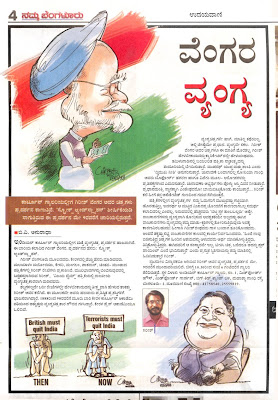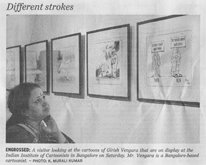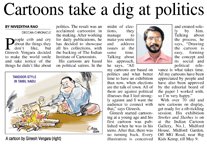 John Thomas, who has worked in the The Statesman, Deccan Herald and Vijay Times, holding various top-level posts in a career spanning more than 30 years, and who went on to teach in journalism schools, speaks on the decline of cartooning at the Indian Institute of Cartoonists, Bangalore. Currently, he teaches journalism students in Garden City College, Bangalore. The exhibition was held by Gireesh Vengara.
John Thomas, who has worked in the The Statesman, Deccan Herald and Vijay Times, holding various top-level posts in a career spanning more than 30 years, and who went on to teach in journalism schools, speaks on the decline of cartooning at the Indian Institute of Cartoonists, Bangalore. Currently, he teaches journalism students in Garden City College, Bangalore. The exhibition was held by Gireesh Vengara.Cartooning in decline
Respected ladies and gentlemen of art and art lovers and fellow dignitaries called to do the honours, need I say what a privilege it is for to be in your midst.
To be invited to be chief guest at the opening of Gireesh Vengara's first exhibition of his works at the place for the art of cartooning in our state is a matter of pride, as I can claim I walked him through the doors to Vijay Times where he did his stint in English newspaper cartooning, just like I did the late Maya Kamath a decade earlier to Deccan Herald.
But that joy is also tinged with a sense of sorrow, in that he is not cartooning in another English daily. (of course Vijay Times itself is no more).
 Irony, like satire and sarcasm, is integral to cartooning. It is the irony about the profession itself that I wish to submit for your thought on this occasion when we celebrate the achievements of Gireesh. I do that with the pain of a journalist who grew up watching and adoring cartoonists and one who rose to be in a position to have a say in what got printed in three publications -- the Deccan Herald, The Statesman and Vijay Times -- in the last two decades of my working life.
Irony, like satire and sarcasm, is integral to cartooning. It is the irony about the profession itself that I wish to submit for your thought on this occasion when we celebrate the achievements of Gireesh. I do that with the pain of a journalist who grew up watching and adoring cartoonists and one who rose to be in a position to have a say in what got printed in three publications -- the Deccan Herald, The Statesman and Vijay Times -- in the last two decades of my working life. I dare say that journalists have been the destroyers of the cartoonist and cartooning.
Time was, when the cartoonist was a revered member of the editorial team of newspapers. Every self-respecting newspaper had larger-than-life cartoonists whose works adorned the front pages in three and even four column sizes, two or three times a week, in addition to the pocket cartoons on page one.
The cartoon was an editorial in the graphic form -- while the pundits in the papers wrote miles of text to say the same thing. The cartoonist was a journalist, regarded one of us, nay.. in a way, one above us. In my younger years, a cartoonist was an Assistant Editor by rank and occupied a cabin just like the other assistant editors who wrote editorials and those ponderous articles. Under the Working Journalists' Act, the cartoonist was a working journalist and no less.
The cartoon was an editorial in the graphic form -- while the pundits in the papers wrote miles of text to say the same thing. The cartoonist was a journalist, regarded one of us, nay.. in a way, one above us. In my younger years, a cartoonist was an Assistant Editor by rank and occupied a cabin just like the other assistant editors who wrote editorials and those ponderous articles. Under the Working Journalists' Act, the cartoonist was a working journalist and no less.
What is the situation today?
How many cartoonists can we now count in the field of journalism after the turn of the century? The Shankars of this world were respected by the doyens of our polity in an Independent India. From that pantheon of giants -- it feels like a generation ago -- perhaps just a Lakshman and Dhar survive. Why have we not seen the ascendance of a worthy second or third generation?
It is not as if our country ran out of talent or that we suffered a talent drain to the West or to the Gulf, when the last two or three decades has been marked by the growth in the number of artists, the phenomenal growth in the business of art and acknowledgement and support to training institutions, however inadequate that may seem.
 The fact is, art and artists have indeed grown. The print media has also grown and editors and managements became even more art conscious as reflected in the design, layout and production quality. What we see in the scenario is: cartooning has made way for illustrations and graphics in all the print publications. Illustrators who readily gave up the palette and brush for the computer to create images in Photoshop, Corel Draw and Paint began to populate the field as cartoonists retired and cartooning as we once knew it gasped and died.
The fact is, art and artists have indeed grown. The print media has also grown and editors and managements became even more art conscious as reflected in the design, layout and production quality. What we see in the scenario is: cartooning has made way for illustrations and graphics in all the print publications. Illustrators who readily gave up the palette and brush for the computer to create images in Photoshop, Corel Draw and Paint began to populate the field as cartoonists retired and cartooning as we once knew it gasped and died.Let me come to my thesis of why I think journalists are responsible for this slow assassination of a respected cerebral art form.
As I mentioned earlier, a newspaper cartoonist of yesteryear was a journalist. He was one of us with our intellectual arrogance. He was accepted as a journalist who could draw his thoughts and, as such, someone we regarded an equal, but privately held in awe. They were educated like us, could think like us and write like us. They were people like us. They were thinkers in their own right whom we could not order around.
src="http://pagead2.googlesyndication.com/pagead/show_ads.js">
Over the years, with the interest in design and colour increasing, the journalists (they after all are the ones who make executive decisions in editorial matters) began to hire artists who could draw to order. They were not taken on the same level as a journalist. They were part of the art or design department. The journalists got used to asking them for illustrations and soon, the journalists became the thinkers who gave the script and told them to draw on order -- just the reverse of what the cerebral cartoonists of yesteryear did.
Why? Because they were fancifully called editorial artists. And not people like
 us. They were often from the art schools and fell victim to the class bias -- of how we treat artisans in society. So, with journalists asserting their exclusive right to be the editorial thinkers and script writers, cartooning was reduced to what we can only call comics or illustrations. Dubyaman became the example of the evolution -- script by the journalist (Jug Suraiya) and drawing by the artist (Neelabh Banerjee).
us. They were often from the art schools and fell victim to the class bias -- of how we treat artisans in society. So, with journalists asserting their exclusive right to be the editorial thinkers and script writers, cartooning was reduced to what we can only call comics or illustrations. Dubyaman became the example of the evolution -- script by the journalist (Jug Suraiya) and drawing by the artist (Neelabh Banerjee).This is less so in language journalism because there, unlike in English, the artist is more comfortable with the idiom of thought, the metaphors, the phrases and the allegories. The language of thought and thereby of business of the publication did indeed cause a class distinction.
How does this situation change?
I remember the opening of this Cartoonists' Gallery -- created by a private vision and finance to encourage cartoonists by holding exhibitions, like what we are inaugurating now, to give them exposure and to hold workshops and interactive sessions to improve their professional standing. What I would plead is, do not give up honouring cartoonists already in business. But actively create cartoonists who are more than artists to restore to the gifted artist the glory of what cerebral cartooning is. Identify those in journalism courses who have the gift of drawing and develop their skills.
John Thomas email id : john.greenwoods@gmail.com













No comments:
Post a Comment